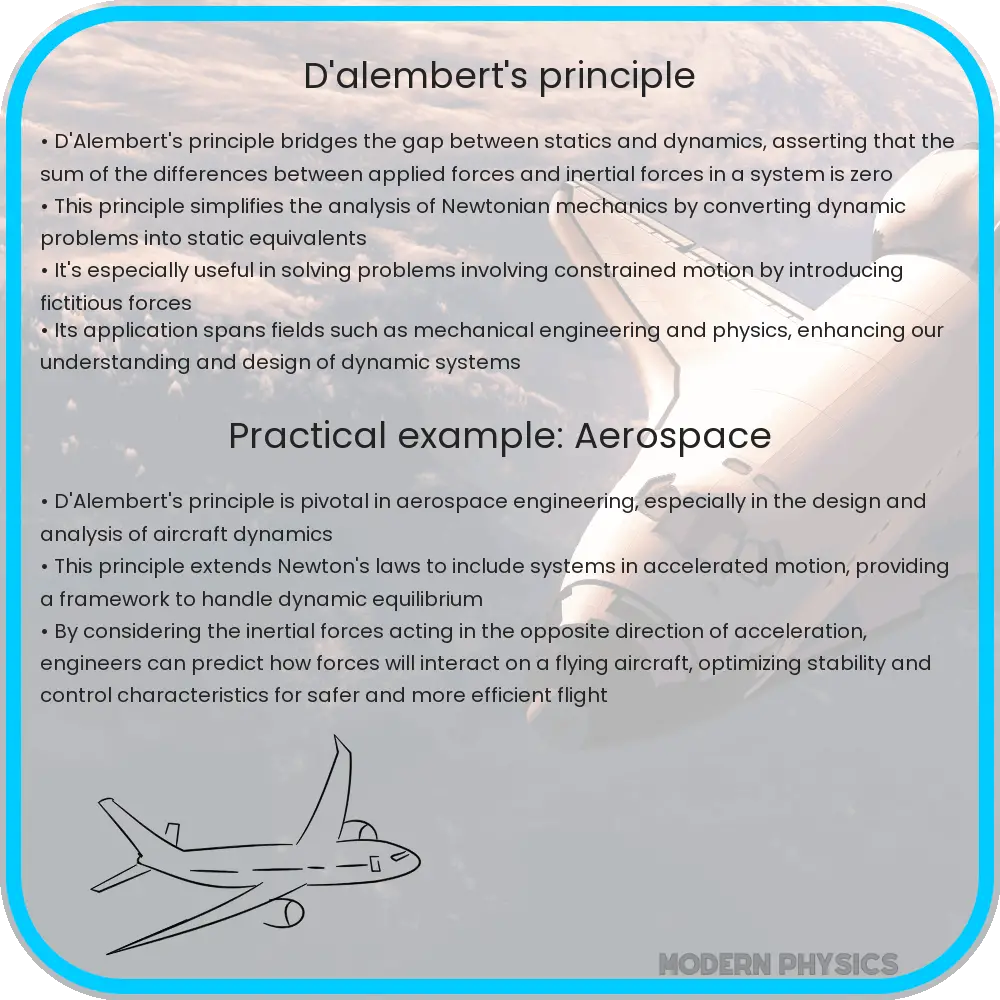D’Alembert’s Principle is a key concept in dynamics, offering a refined view of Newton’s Second Law to analyze complex systems.

Introduction to D’Alembert’s Principle in Dynamics
D’Alembert’s Principle is a cornerstone concept in the field of dynamics, which is a branch of physics that deals with the motion of bodies under the action of forces. This principle offers a refined view of Newton’s Second Law of Motion, and it is particularly powerful for solving problems involving complex systems of particles and rigid bodies.
Understanding Newton’s Second Law
Before diving into D’Alembert’s Principle, it’s important to have a clear understanding of Newton’s Second Law of Motion. Simply stated, this law says that the force acting on an object is equal to the mass of that object multiplied by its acceleration. In equation form, it is often expressed as:
\[ F = m * a \]
where:
- F represents the force applied,
- m is the mass of the object, and
- a is the acceleration of the object.
The Emergence of D’Alembert’s Principle
Developed by the French mathematician and physicist Jean le Rond d’Alembert in the mid-18th century, D’Alembert’s Principle introduces the concept of inertial forces. It effectively transforms a dynamic problem into a static one by considering the equilibrium of forces, including both the actual external forces and the fictitious inertial forces. This transformation is immensely useful as it simplifies the analysis of the system.
Formal Statement of D’Alembert’s Principle
D’Alembert’s Principle can be formally stated as:
“The total virtual work done by the impressed forces plus the inertial forces on a system of particles in any virtual displacement is zero.
In a more mathematical form, the principle is expressed as:
\[ \sum (F_i – m_i * a_i) \cdot \delta r_i = 0 \]
where:
- Fi represents the external force on the ith particle,
- mi is the mass of the ith particle,
- ai is the acceleration of the ith particle,
- \(\delta r_i\) is a virtual displacement which is compatible with the constraints of the system.
This equation implies that the sum of the forces (external and inertial) acting on a particle times a small hypothetical displacement equals zero, underscoring the condition of equilibrium. By considering these small virtual displacements, which do not necessarily occur, the principle provides a powerful method for studying the dynamics of a system.
Application of D’Alembert’s Principle
D’Alembert’s Principle is extensively used in engineering, particularly in the fields of mechanical and aerospace engineering. Its application simplifies the analysis of complex mechanical systems by reducing the dynamics problem to one of static equilibrium. This makes it easier to design and analyze mechanisms such as engines, cranes, and robots.
For example, consider a system consisting of a pulley with a weight attached. The complexity of solving the system’s dynamics using just Newton’s laws could be immense due to the multiple components interacting. However, applying D’Alembert’s Principle allows us to include the inertial forces of the weight and the pulley as if they were static forces. This simplifies calculations and conceptual understanding.
Benefits and Limitations
Like all scientific principles, D’Alembert’s Principle comes with its benefits and limitations. One of the major advantages is its ability to simplify complex physics problems into manageable static problems. It is particularly beneficial in the study of systems with multiple moving parts and allows for easier computation and conceptualization.
However, a limitation lies in the idealizations involved, such as assuming perfect rigidity and ignoring friction and air resistance. These are common restrictions in many theoretical physics approaches that can be somewhat removed from real-world conditions. Thus, while D’Alembert’s Principle is a powerful tool in theoretical mechanics, its practical application must consider these limitations.
Conclusion
D’Alembert’s Principle offers a significant extension and reformation of Newton’s Second Law by incorporating inertial forces and allowing for the analysis of complex systems in a state of static equilibrium. By shifting the focus from dynamic to static, it provides a clearer and more simplified platform for understanding and solving physical problems involving motion. While its effectiveness is influenced by certain idealistic assumptions, the principle remains a cornerstone in the fields of physics and engineering, especially effective in the kinematic analysis of mechanical systems.
Whether you are a student of physics, an aspiring engineer, or a professional in the field, mastering D’Alembert’s Principle can enhance your understanding of dynamics and open up new avenues for solving technical challenges in mechanical designs and applications.
